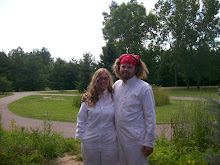So the established colony that Keith and I worked so hard for in Holt, ended up having a injured, and eventually dead queen. It would not have been much of an issue if it had not been so late in the season, or if she were working strongly enough to lay some more brood to prevent a queenless colony. Sometimes when a colony become queenless, the worker's will take a larvae and remove it from a standard worker cell and put it in a queen cup.
This is a cell or 'cup' the bee's fashion out of wax, but each cell size is different, and those different cell sizes tell the queen or the workers what type of bee will be laid in that particular cell. Worker's (female) and Drones (male) are laid horizontal in the standard honeycomb shape. Drone cells are larger. Queen cups are built on the bottom of honeycomb and are vertical as opposed to horizontal. How each bee is fed and which cell the larvae has been laid, will determine the sex of the bee. A queen bee is just a sexually mature female bee and the worker population are just unfertilized and sexually immature females.
If a colony was to become queenless the female workers would take a laid larvae that has not been capped over with wax, and move it into that queen cup. Within a queen cup the new larvae is fed special blends of the bee's nutrients called Royal Jelly. That is why it is so valuable, not all bee's produce it, and it is only kept in very small amounts in the hive (especially compared to the amount of wax, pollen, nectar, and honey!) Since the queen does not tend to her own brood once they are laid, it is up to the worker's to provide protection and nutrition to the gestating larvae.
Sometimes when a colony becomes queenless, there is not enough established brood to simply remove a larvae and place it into a newly made queen cup. When this happens, a female worker bee (read: sexually immature and unfertilized) will try to step up and repopulate the hive. The major problem with this is that she is infertile and has not been inseminated by the drone population. Therefore the worker bee is only capable of laying unfertilized eggs, which will only produce more drones, or male bee's.
This is not beneficial to the hive at all. At season's end, when the female working population prepares for winter, they will drive all drones out of the hive. It's tough to say, but the bee's rely mostly on the female population to stay active and have enough stores of honey to survive; the males merely mooch off of their work and contribute nothing to the hive other than if they are part of the lucky few that the queen chooses to mate with.
The above scenario happens to be the situation we are in now. We captured an established colony, late in the honey-flow season, and the queen died. In her place a female worker tried to lay new brood, but only would produce a heavy drone pattern. We had decided on combining the hive to prevent the chance that we could lose the entire colony over the winter if we left them to survive knowing they were not strong enough. We have since introduced them to our WS1, which is the first feral colony we captured in Brighton. The hive is located at a small organic farm in Whitmore Lake, and appears to be improving by the day.
It is not a very technical procedure to introduce two colonies, but it is something to do carefully because nest scent and pheromones are a very integral part to the bee's acceptance of one another. To introduce two colonies you only need a sheet of newspaper; but the sheet is the most important tool in a successful combination of two colonies. Setting the newspaper between the established colony and the new weak colony you are adding allows them to keep a barrier. Slit a few holes in the newspaper for the bee's to chew through. In the meantime their personal nest scents are mingling and they are becoming aware of another presence. As the bee's chew through the paper their scent's will mingle and the queen will accept the foreign bee's into her colony. As the paper disappears, their heat and scent mix and the weak colony will accept their new queen and the stronger, established colony, will not harm the newly added bee's.
Ultimately our goal is to combine these two colonies for the winter, and to give them adequate stores to thrive in the cold Michigan winter, and to split them apart in the spring to create two healthy colonies.
To make a split it will involve using some of the healthy brood (baby bee's) and some of the existing worker's and putting them into another hive. Without a queen to produce that calming pheromone, the bee's will not have order and will become anxious. This is the case where we hope the first description of requeening will come into play. If the brood and worker's are healthy they will create a queen cup, move an egg into the cup, and create their own new queen!
Voila, two healthy colonies from one!! We'll let you know how 'D' and "WS1' progress throughout the season and into winter!!
Saturday, August 1, 2009
Subscribe to:
Posts (Atom)




